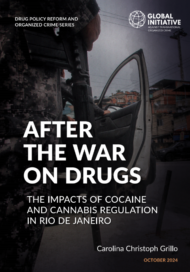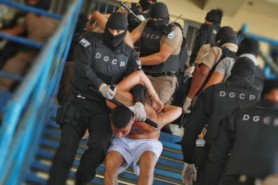Posted on 11 Apr 2018
This report contains a comprehensive measure of peacefulness in Mexico from 2003 – 2017.
“Peace in Mexico has declined for a second year in a row, as indicated by the 2018 Mexico Peace Index. Peace deteriorated by 10.7% from the previous year.”
The most authoritative research into Mexico’s peacefulness, the Mexico Peace Index, reported that 2017 was the most violent year on record. The report, produced annually by the Institute for Economics and Peace, shows that peace deteriorated by 10.7% from the previous year. Of the 32 states in Mexico, only seven improved in peacefulness in 2017, and 25 states deteriorated.
Two years of escalating violence
Mexico has reached historically high levels of violence and homicide. This deterioration in peace is largely driven by the 25% increase in homicide rate from the previous year, as well as the rise in gun violence for the second year in a row. Over 29,000 people in Mexico in 2017 were direct victims of homicide, and 69% of these crimes were committed with a firearm. The rate of homicides and assaults committed with a firearm rose 36% from the prior year, 2016.
Organised crime and widespread lawlessness
Organized crime remains Mexico’s most significant security challenge. Homicides related clashes between organized crime groups escalated in 2017, as cartel leadership were removed or arrested, fracturing groups and creating internal and external power struggles. However, the data indicates a more widespread deterioration in peacefulness. The rate of organized crime related offenses (kidnapping, extortion and drug crimes) was fairly flat in 2017, showing only a 0.9% rise. But the violent crime rate, which includes assault, robbery and sexual violence, rose 15%, based on increase in all three crimes. Domestic violence has increased 32% over the three years leading up to December 2017. Importantly, violence inside and outside the home track together, suggesting that deteriorations in peace – whether they stem from organized crime or other dynamics – are having widespread effects.
Economic impact of violence
The economic impact of violence increased by 15% in 2017 – or by 634 billion pesos. The economic impact of violence in Mexico is equivalent to 21% of the country’s GDP – 4.72 trillion pesos (US$249 billion) in 2017. On a per person basis, the economic impact of violence was 33,118 pesos, more than four times the average monthly salary of a Mexican worker. The largest contributor to the economic impact of violence in 2017 was homicide, accounting for 46% of the total impact. Mexico is spending on domestic security and justice systems at the same level as Denmark and Luxembourg. Given the levels of violence in Mexico, this indicates a serious lack of resources in these two sectors. Mexico needs to make more and better investments in institutions to reduce and contain violence in order to build and sustain peace.
Improvements
Only one indicator of the Mexico Peace Index improved from 2016 to 2017: detention without a sentence. The number of inmates held without a sentence has fallen by 26% since its peak in 2014. Additionally, ten states have brought their prison populations in line with prison capacity since 2015, reflecting efforts to improve justice processes across Mexico. The research of the Institute for Economics and Peace shows that the most peaceful states tend to be the ones that have a higher percentage of citizens reporting robbery crimes to police. This highlights an important note about cooperation between the community and the institutions of justice: building a relationship of trust is an important component in creating higher levels of peace.
Institutional capacity for peace
The institutional capacity for violence containment remains weak in Mexico. The equivalent of only one percent of the Mexican GDP is spent on domestic security and the justice system, which is only 60% of the OECD average. It appears from the report that the public’s concerns regarding impunity and citizens’ trust in judges rises and falls with the rise and fall in violence. This indicates that political support is tied to building peace – something to be observed in the 2018 election. Especially as the percentage of Mexicans reporting a high level of trust in public security institutions in 2017 fell to 18% – its lowest level since 2012.
Positive Peace in Mexico
Strategic investments in the eight pillars of Positive Peace is essential for improving the overall peacefulness of Mexico. Despite an above-average performance in Positive Peace as a whole, there are three critical downfalls that contribute to the institutional weaknesses in Mexico that allow for organised crime and widespread lawlessness to thrive. The three pillars of Positive Peace that need the most attention are Mexico’s well-functioning government, low levels of corruption, and free flow of information. The weak scores in these three pillars have trapped Mexico in a cycle of violence. What’s also concerning, is these three pillars of Positive Peace are continuing to deteriorate. It is critical that these pillars be strengthened in context of systemic Positive Peace. The imbalance between Mexico’s Pillar scores creates a risk for increased violence. Global research shows that interventions to improve one Pillar can be counterproductive if other Pillars are not strengthened in tandem. It is not sufficient for policy and security frameworks to focus solely on one issue, like drug violence or organised crime, if achieving long-lasting peace is the aim. Instead, the entire system needs to be stimulated in a strategic sequence in order to be an actionable policy statement for peacebuilding.
Looking forward
In the 2018 elections, peace and security play an imperative role in determining the outcomes. The 2018 Mexico Peace Index provides the evidence for policy makers, civil society organisations, business leaders and community members to advance new and broader peacebuilding solutions. At the very least the Mexico Peace Index highlights the need to:
- Reduce corruption and impunity
- Build institutional capacity based on transparency and accountability
- Protect youth
- Protect public spaces
- Build trust by demonstrating progress
- Address the specific dynamics behind gun violence, illicit trade, extortion, kidnapping and different forms of homicide.
The report is available in both English and Spanish, please see below.
Click here for the Interactive storymap (Español)



